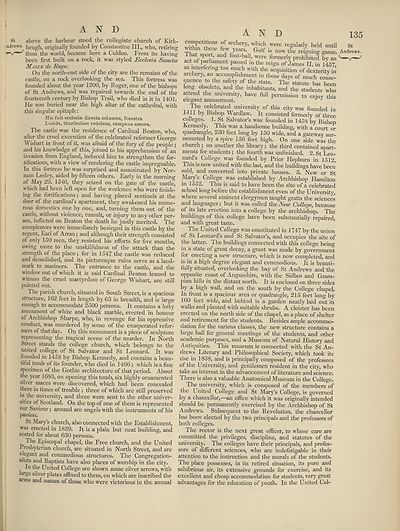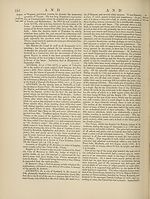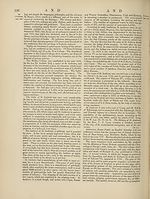Encyclopaedia Britannica > Volume 3, Anatomy-Astronomy
(143) Page 135
Download files
Complete book:
Individual page:
Thumbnail gallery: Grid view | List view

>
AND
St above the harbour stood the collegiate church of Kirk-
ndrews. heugh, originally founded by Constantine III., who, retiring
from the world, became here a Culdee. From its having
been first built on a rock, it was styled Ecclesia Sanctce
Mamie de Rupe.
On the north-east side of the city are the remains of the
castle, on a rock overlooking the sea. This fortress was
founded about the year 1200, by Roger, one of the bishops
of St Andrews, and was repaired towards the end of the
fourteenth century by Bishop Trail, who died in it in 1401.
He was buried near the high altar of the cathedral, with
this singular epitaph:
Hie fait ecclesise directa columna, fenestra
Lucida, thuribulum redolens, campana sonora.
The castle was the residence of Cardinal Beaton, who,
after the cruel execution of the celebrated reformer George
Wishart in front of it, was afraid of the fury of the people;
and his knowledge of this, joined to his apprehension of an
invasion from England, induced him to strengthen the for¬
tifications, with a view of rendering the castle impregnable.
In this fortress he was surprised and assassinated by Nor¬
man Lesley, aided by fifteen others. Early in the morning
of May 29. 1546, they seized on the gate of the castle,
which had been left open for the workmen who were finish¬
ing the fortifications; and having placed sentinels at the
door of the cardinal’s apartment, they awakened his nume¬
rous domestics one by one, and, turning them out of the
castle, without violence, tumult, or injury to any other per¬
son, inflicted on Beaton the death he justly merited. The
conspirators were immediately besieged in this castle by the
regent, Earl of Arran; and although their strength consisted
of only 150 men, they resisted his efforts for five months,
owing more to the unskilfulness of the attack than the
strength of the place; for in 1547 the castle was reduced
and demolished, and its picturesque ruins serve as a land¬
mark to mariners. The entrance to the castle, and the
window out of which it is said Cardinal Beaton leaned to
witness the cruel martyrdom of George Wishart, are still
pointed out.
The parish church, situated in South Street, is a spacious
structure, 162 feet in length by 63 in breadth, and is large
enough to accommodate 2500 persons. It contains a lofty
monument of white and black marble, erected in honour
of Archbishop Sharpe, who, in revenge for his oppressive
conduct, was murdered by some of the exasperated refor¬
mers of that day. On this monument is a piece of sculpture
representing the tragical scene of the murder. In North
Street stands the college church, which belongs to the
united college of St Salvator and St Leonard. It was
founded in 1458 by Bishop Kennedy, and contains a beau¬
tiful tomb of its founder, who died in 1466; which is a fine
specimen of the Gothic architecture of that period. About
the year 1683, on opening this tomb, six highly ornamented
silver maces were discovered, which had been concealed
there in times of trouble ; three of which are still preserved
in the university, and three were sent to the other univer¬
sities of Scotland. On the top of one of them is represented
our Saviour; around are angels with the instruments of his
passion.
St Mary’s church, also connected with the Establishment,
was erected in 1839. It is a plain but neat building, and
seated for about 630 persons.
4 he Episcopal chapel, the Free church, and the United
Fresbyterian church, are situated in North Street, and are
elegant and commodious structures. The Congregation-
alists and Baptists have also places of worship in the city.
In the United College are shown some silver arrows, with
arge silver plates affixed to them, on which are inscribed the
arms and names of those who were victorious in the annual
and
135
competitions of archery, which were regularly held until
within these few years Golf is now the reigning game.
at sport, and foot-ball, were formerly prohibited by an
act of parliament passed in the reign of James II. in 1457
as interfering too much with the acquisition of dexterity in
archery, an accomplishment in those days of much conse¬
quence to the safety of the state. The statute has been
long obsolete, and the inhabitants, and the students who
attend the university, have full permission to enjoy this
elegant amusement. J :
HMhu c^rated u^ersity of this city was founded in
1411 by Bishop Wardlaw. It consisted formerly of three
colleges. 1. St Salvator’s was founded in 1458 by Bishop
Kennedy. This was a handsome building, with a court or
quadrangle, 230 feet long by 150 wide, and a gateway sur¬
mounted by a spire 156 feet high. On one side was the
church ; on another the library; the third contained apart¬
ments for students ; the fourth was unfinished. 2. St Leo¬
nard’s College was founded by Prior Hepburn in 1512.
This is now united with the last, and the buildings have been
sold, and converted into private houses. 3. New or St
Mary’s College was established by Archbishop Hamilton
in 1552. This is said to have been the site of a celebrated
school long before the establishment even of the University,
where several eminent clergymen taught gratis the sciences
and languages; but it was called the New College, because
of its late erection into a college by the archbishop. The
buildings of this college have been substantially repaired,
and with great taste.
The United College was constituted in 1747 by the union
of St Leonard’s and St Salvator’s, and occupies the site of
the latter. The buildings connected with this college being
in a state of great decay, a grant was made by government
for erecting a new structure, which is now completed, and
is in a high degree elegant and commodious. It is beauti¬
fully situated, overlooking the bay of St Andrews and the
opposite coast of Angusshire, with the Sidlaw and Gram¬
pian hills in the distant north. It is enclosed on three sides
by a high wall, and on the south by the College chapel.
In front is a spacious area or quadrangle, 215 feet long by
160 feet wide, and behind is a garden neatly laid out in
walks and planted with suitable shrubs. A cloister has been
erected on the north side of the chapel, as a place of shelter
and retirement for the students. Besides ample accommo¬
dation for the various classes, the new structure contains a
large hall for general meetings of the students, and other
academic purposes, and a Museum of Natural History and
Antiquities. This museum is connected with the St An¬
drews Literary and Philosophical Society, which took its
rise in 1838, and is principally composed of the professors
of the University, and gentlemen resident in the city, who
take an interest in the advancement of literature and science.
I here is also a valuable Anatomical Museum in the College.
The university, which is composed of the members of
the United College and St Mary’s College, is governed
by a chancellor,—an office Avhich it was originally intended
should be permanently exercised by the Archbishop of St
Andrews. Subsequent to the Revolution, the chancellor
has been elected by the two principals and the professors of
both colleges.
The rector is the next great officer, to whose care are
committed the privileges, discipline, and statutes of the
university. The colleges have their principals, and profes¬
sors of different sciences, who are indefatigable in their
attention to the instruction and the morals of the students.
The place possesses, in its retired situation, its pure and
salubrious air, its extensive grounds for exercise, and its
excellent and cheap accommodation for students, very great
advantages for the education of youth. In the United Col-
St
Andrews.
AND
St above the harbour stood the collegiate church of Kirk-
ndrews. heugh, originally founded by Constantine III., who, retiring
from the world, became here a Culdee. From its having
been first built on a rock, it was styled Ecclesia Sanctce
Mamie de Rupe.
On the north-east side of the city are the remains of the
castle, on a rock overlooking the sea. This fortress was
founded about the year 1200, by Roger, one of the bishops
of St Andrews, and was repaired towards the end of the
fourteenth century by Bishop Trail, who died in it in 1401.
He was buried near the high altar of the cathedral, with
this singular epitaph:
Hie fait ecclesise directa columna, fenestra
Lucida, thuribulum redolens, campana sonora.
The castle was the residence of Cardinal Beaton, who,
after the cruel execution of the celebrated reformer George
Wishart in front of it, was afraid of the fury of the people;
and his knowledge of this, joined to his apprehension of an
invasion from England, induced him to strengthen the for¬
tifications, with a view of rendering the castle impregnable.
In this fortress he was surprised and assassinated by Nor¬
man Lesley, aided by fifteen others. Early in the morning
of May 29. 1546, they seized on the gate of the castle,
which had been left open for the workmen who were finish¬
ing the fortifications; and having placed sentinels at the
door of the cardinal’s apartment, they awakened his nume¬
rous domestics one by one, and, turning them out of the
castle, without violence, tumult, or injury to any other per¬
son, inflicted on Beaton the death he justly merited. The
conspirators were immediately besieged in this castle by the
regent, Earl of Arran; and although their strength consisted
of only 150 men, they resisted his efforts for five months,
owing more to the unskilfulness of the attack than the
strength of the place; for in 1547 the castle was reduced
and demolished, and its picturesque ruins serve as a land¬
mark to mariners. The entrance to the castle, and the
window out of which it is said Cardinal Beaton leaned to
witness the cruel martyrdom of George Wishart, are still
pointed out.
The parish church, situated in South Street, is a spacious
structure, 162 feet in length by 63 in breadth, and is large
enough to accommodate 2500 persons. It contains a lofty
monument of white and black marble, erected in honour
of Archbishop Sharpe, who, in revenge for his oppressive
conduct, was murdered by some of the exasperated refor¬
mers of that day. On this monument is a piece of sculpture
representing the tragical scene of the murder. In North
Street stands the college church, which belongs to the
united college of St Salvator and St Leonard. It was
founded in 1458 by Bishop Kennedy, and contains a beau¬
tiful tomb of its founder, who died in 1466; which is a fine
specimen of the Gothic architecture of that period. About
the year 1683, on opening this tomb, six highly ornamented
silver maces were discovered, which had been concealed
there in times of trouble ; three of which are still preserved
in the university, and three were sent to the other univer¬
sities of Scotland. On the top of one of them is represented
our Saviour; around are angels with the instruments of his
passion.
St Mary’s church, also connected with the Establishment,
was erected in 1839. It is a plain but neat building, and
seated for about 630 persons.
4 he Episcopal chapel, the Free church, and the United
Fresbyterian church, are situated in North Street, and are
elegant and commodious structures. The Congregation-
alists and Baptists have also places of worship in the city.
In the United College are shown some silver arrows, with
arge silver plates affixed to them, on which are inscribed the
arms and names of those who were victorious in the annual
and
135
competitions of archery, which were regularly held until
within these few years Golf is now the reigning game.
at sport, and foot-ball, were formerly prohibited by an
act of parliament passed in the reign of James II. in 1457
as interfering too much with the acquisition of dexterity in
archery, an accomplishment in those days of much conse¬
quence to the safety of the state. The statute has been
long obsolete, and the inhabitants, and the students who
attend the university, have full permission to enjoy this
elegant amusement. J :
HMhu c^rated u^ersity of this city was founded in
1411 by Bishop Wardlaw. It consisted formerly of three
colleges. 1. St Salvator’s was founded in 1458 by Bishop
Kennedy. This was a handsome building, with a court or
quadrangle, 230 feet long by 150 wide, and a gateway sur¬
mounted by a spire 156 feet high. On one side was the
church ; on another the library; the third contained apart¬
ments for students ; the fourth was unfinished. 2. St Leo¬
nard’s College was founded by Prior Hepburn in 1512.
This is now united with the last, and the buildings have been
sold, and converted into private houses. 3. New or St
Mary’s College was established by Archbishop Hamilton
in 1552. This is said to have been the site of a celebrated
school long before the establishment even of the University,
where several eminent clergymen taught gratis the sciences
and languages; but it was called the New College, because
of its late erection into a college by the archbishop. The
buildings of this college have been substantially repaired,
and with great taste.
The United College was constituted in 1747 by the union
of St Leonard’s and St Salvator’s, and occupies the site of
the latter. The buildings connected with this college being
in a state of great decay, a grant was made by government
for erecting a new structure, which is now completed, and
is in a high degree elegant and commodious. It is beauti¬
fully situated, overlooking the bay of St Andrews and the
opposite coast of Angusshire, with the Sidlaw and Gram¬
pian hills in the distant north. It is enclosed on three sides
by a high wall, and on the south by the College chapel.
In front is a spacious area or quadrangle, 215 feet long by
160 feet wide, and behind is a garden neatly laid out in
walks and planted with suitable shrubs. A cloister has been
erected on the north side of the chapel, as a place of shelter
and retirement for the students. Besides ample accommo¬
dation for the various classes, the new structure contains a
large hall for general meetings of the students, and other
academic purposes, and a Museum of Natural History and
Antiquities. This museum is connected with the St An¬
drews Literary and Philosophical Society, which took its
rise in 1838, and is principally composed of the professors
of the University, and gentlemen resident in the city, who
take an interest in the advancement of literature and science.
I here is also a valuable Anatomical Museum in the College.
The university, which is composed of the members of
the United College and St Mary’s College, is governed
by a chancellor,—an office Avhich it was originally intended
should be permanently exercised by the Archbishop of St
Andrews. Subsequent to the Revolution, the chancellor
has been elected by the two principals and the professors of
both colleges.
The rector is the next great officer, to whose care are
committed the privileges, discipline, and statutes of the
university. The colleges have their principals, and profes¬
sors of different sciences, who are indefatigable in their
attention to the instruction and the morals of the students.
The place possesses, in its retired situation, its pure and
salubrious air, its extensive grounds for exercise, and its
excellent and cheap accommodation for students, very great
advantages for the education of youth. In the United Col-
St
Andrews.
Set display mode to:
![]() Universal Viewer |
Universal Viewer | ![]() Mirador |
Large image | Transcription
Mirador |
Large image | Transcription
Images and transcriptions on this page, including medium image downloads, may be used under the Creative Commons Attribution 4.0 International Licence unless otherwise stated. ![]()
| Encyclopaedia Britannica > Encyclopaedia Britannica > Volume 3, Anatomy-Astronomy > (143) Page 135 |
|---|
| Permanent URL | https://digital.nls.uk/193759207 |
|---|
| Attribution and copyright: |
|
|---|---|
| Shelfmark | EB.16 |
|---|---|
| Description | Ten editions of 'Encyclopaedia Britannica', issued from 1768-1903, in 231 volumes. Originally issued in 100 weekly parts (3 volumes) between 1768 and 1771 by publishers: Colin Macfarquhar and Andrew Bell (Edinburgh); editor: William Smellie: engraver: Andrew Bell. Expanded editions in the 19th century featured more volumes and contributions from leading experts in their fields. Managed and published in Edinburgh up to the 9th edition (25 volumes, from 1875-1889); the 10th edition (1902-1903) re-issued the 9th edition, with 11 supplementary volumes. |
|---|---|
| Additional NLS resources: |
|

